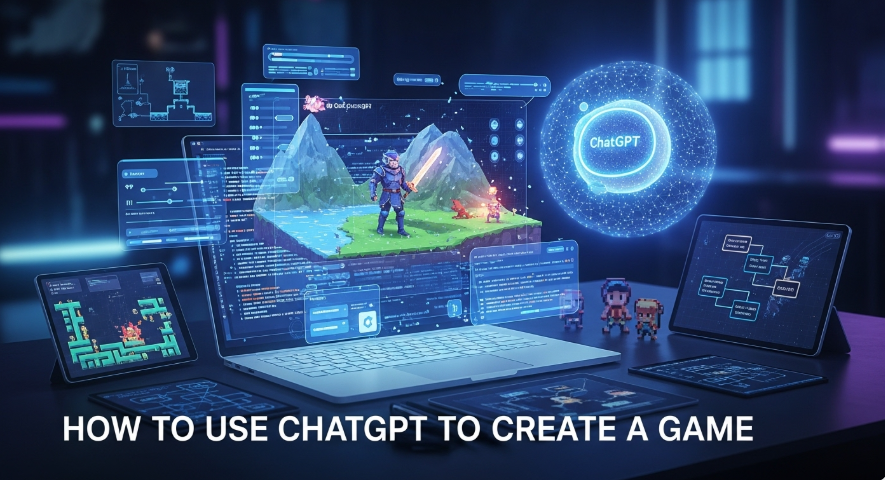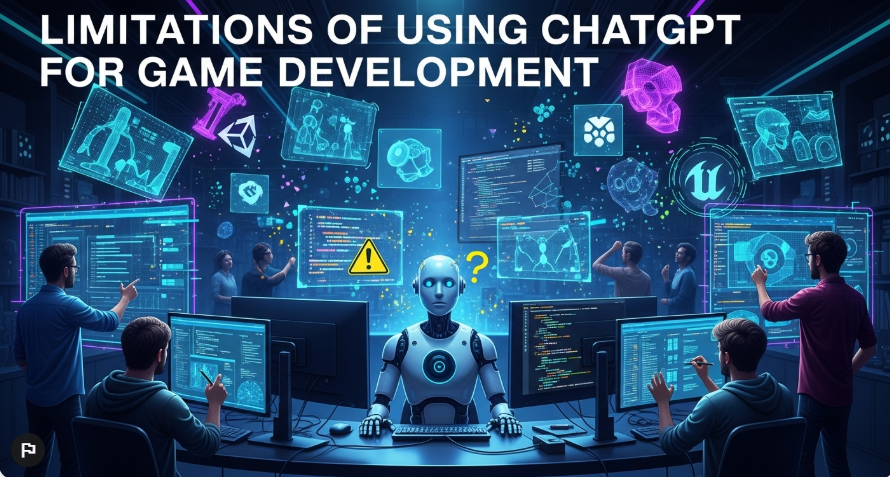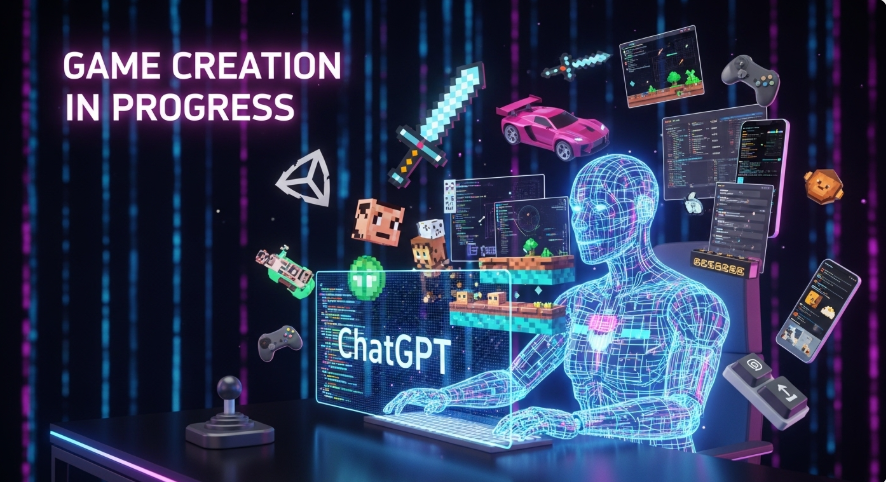Artificial intelligence (AI) has reshaped many industries, and game development is no exception. ChatGPT, created by OpenAI, has sparked widespread interest in its ability to assist in creating games. Many wonder if this AI tool can truly help build games, especially for those with little to no coding experience.
What is ChatGPT?
ChatGPT is an AI-powered chatbot that uses advanced language models, such as GPT-4o or o3, to understand and generate human-like text. It can answer questions, write stories, and produce code in various programming languages. Its versatility has made it a popular tool for tasks ranging from writing to programming, including game development. As of 2025, ChatGPT continues to evolve, with recent updates like GPT-4.5 enhancing its reasoning and code generation capabilities.
Can ChatGPT Really Create Games?
ChatGPT can assist in creating games, particularly simple ones, but it’s not a complete solution. It can generate code for games like Pong, Snake, or text-based adventures, suggest game ideas, and help troubleshoot errors. However, it cannot build a fully functional game without human input. For beginners, ChatGPT is a valuable tool to start exploring game development, but for complex projects, it works best as a support tool alongside human creativity and expertise.
Examples of Games Created with ChatGPT
- Pong: A classic paddle-and-ball game created in minutes using HTML, CSS, and JavaScript.
- Text-Based Adventures: Interactive stories where players make choices, similar to Zork.
- Simple Platformers: Basic 2D games with player movement and jumping mechanics.
How to Use ChatGPT to Create a Game

Here’s a step-by-step guide to creating a game with ChatGPT, based on insights from tutorials and real-world experiences:
- Choose a Game Idea
- Ask ChatGPT for simple game ideas or come up with your own.
- Example prompt: “Suggest a simple game idea that I can create with ChatGPT.”
- Example response: ChatGPT might suggest a “Guess the Number” game or a basic 2D platformer.
- Select a Game Engine or Platform
- Choose a platform like Unity (C#), Godot (GDScript), or browser-based games (HTML, CSS, JavaScript).
- Ask ChatGPT for recommendations, but verify with official documentation, as AI may suggest outdated tools.
- Example prompt: “Which game engine is best for a beginner creating a 2D game?”
- Generate Code
- Request code for your game idea and platform.
- Example prompt: “Can you provide the code for a simple Pong game in Python?”
- ChatGPT may generate code using libraries like Pygame for Python or JavaScript for browser games.
- Understand and Modify the Code
- Review the code to understand its structure. Ask ChatGPT to explain it if needed.
- Example prompt: “Explain this Pong game code line by line.”
- Modify the code to customize the game, such as changing colors or adding features.
- Test and Debug
- Run the code in your chosen environment and test the game.
- If errors occur, ask ChatGPT for debugging help. Be cautious, as it may not always provide accurate fixes.
- Example prompt: “Why is my game crashing? Here’s the code…”
- Enhance the Game
- Add features like sound effects, scoring, or additional levels.
- Example prompt: “How can I add sound effects to this game?”
Example: Creating a Pong Game
A tutorial from Tilburg.ai demonstrates how to create a Pong game in under 5 minutes using ChatGPT and Grimoire, a specialized GPT for programming. The process involves:
- Accessing Grimoire via the GPT Store.
- Prompting: “Can you make a Pong game that I can run in my browser?”
- Receiving HTML, CSS, and JavaScript code.
- Testing the game via a downloadable link and deploying it on Netlify for sharing.
Limitations of Using ChatGPT for Game Development

While ChatGPT is a powerful tool, it has notable limitations:
- Lack of Original Creativity: ChatGPT generates ideas based on existing patterns, which may result in less unique concepts compared to human-designed games.
- Complexity Challenges: It struggles with complex games requiring advanced logic, 3D graphics, or multiplayer functionality.
- Prompt Dependency: The quality of output depends on clear, specific prompts. Vague requests may lead to incomplete or incorrect code.
- No Visual Design: ChatGPT cannot create graphics, animations, or other visual assets, requiring users to source these elsewhere.
- Potential for Errors: ChatGPT may suggest outdated or incorrect code, especially for niche platforms or libraries.
Common Mistakes and How to Avoid Them
Real-world experiences highlight common pitfalls when using ChatGPT for game development. Here are key mistakes and how to avoid them, based on insights from developers:
| Mistake | Description | How to Avoid |
|---|---|---|
| Overreliance on ChatGPT | Copying code without understanding it can lead to unfixable errors. | Learn basic programming concepts and review ChatGPT’s code to understand its logic. |
| Using Outdated Information | ChatGPT may suggest deprecated methods or libraries. | Cross-check code with official documentation or community forums. |
| Lack of Version Control | Without version control, fixing broken code or reverting changes is difficult. | Use tools like GitHub to track changes and maintain backups. |
| Not Learning Basics | Relying solely on ChatGPT hinders long-term growth as a developer. | Use ChatGPT as a learning aid, not a replacement for studying programming. |
Case Study: Lessons from a Beginner
An article from Digital Trends describes a developer’s experience using ChatGPT to build their first game. Initially, they made rapid progress with ChatGPT’s code examples but hit a dead end when the game broke due to lack of understanding. They learned to:
- Write code by hand to build knowledge.
- Use ChatGPT for explanations rather than full solutions.
- Implement version control with GitHub to avoid losing progress.
Success Stories: Real-World Examples
Developers have successfully used ChatGPT to create games, showcasing its potential:
- Tilburg.ai: Created a browser-based Pong game in under 5 minutes using ChatGPT and Grimoire, demonstrating how quickly AI can produce functional code.
- TheTinyCTO: Built a small game from scratch with zero coding experience, using only ChatGPT prompts to generate code for an Elixir Phoenix project.
- Digital Trends: A beginner developer used ChatGPT to create a simple game, learning from mistakes like overreliance on AI-generated code.
These examples highlight ChatGPT’s ability to make game development accessible, especially for novices, when used thoughtfully.
The Future of AI in Game Development
As of 2025, AI’s role in game development is expanding. The release of GPT-4.5, codenamed “Orion,” has improved ChatGPT’s reasoning and code generation, making it more effective for tasks like:
- Procedural Content Generation: Automating the creation of game assets, quests, or entire worlds.
- Enhanced NPC Interactions: Generating realistic dialogue and behaviors for non-player characters.
- Custom GPTs: Building specialized AI models for specific game development tasks.
The anticipated release of GPT-5 in late 2025 is expected to further enhance these capabilities, potentially enabling more complex game mechanics and reducing development time. However, some developers express concern that overreliance on AI could reduce the originality of games, emphasizing the need for human creativity to remain central.
Research Insights
A 2024 study from arXiv.org notes a surge in research on GPT models in game development since 2020. Key applications include:
- Procedural content generation (25 studies).
- Mixed-initiative game design and development (11 studies).
- Mixed-initiative gameplay (10 studies).
- Playing games (6 studies).
- Game user research (3 studies).
This growing interest suggests AI tools like ChatGPT will continue to shape the industry.
Conclusion
ChatGPT is a powerful tool for game development, particularly for beginners looking to create simple games. It can generate code, suggest ideas, and assist with debugging, making game creation more accessible. However, its limitations—such as lack of original creativity and struggles with complex projects—mean it’s best used as a support tool alongside human expertise. By following the steps in this guide, avoiding common mistakes, and staying informed about AI advancements, you can harness ChatGPT to bring your game ideas to life. As AI technology evolves, its role in game development will only grow, offering exciting possibilities for developers of all skill levels.
